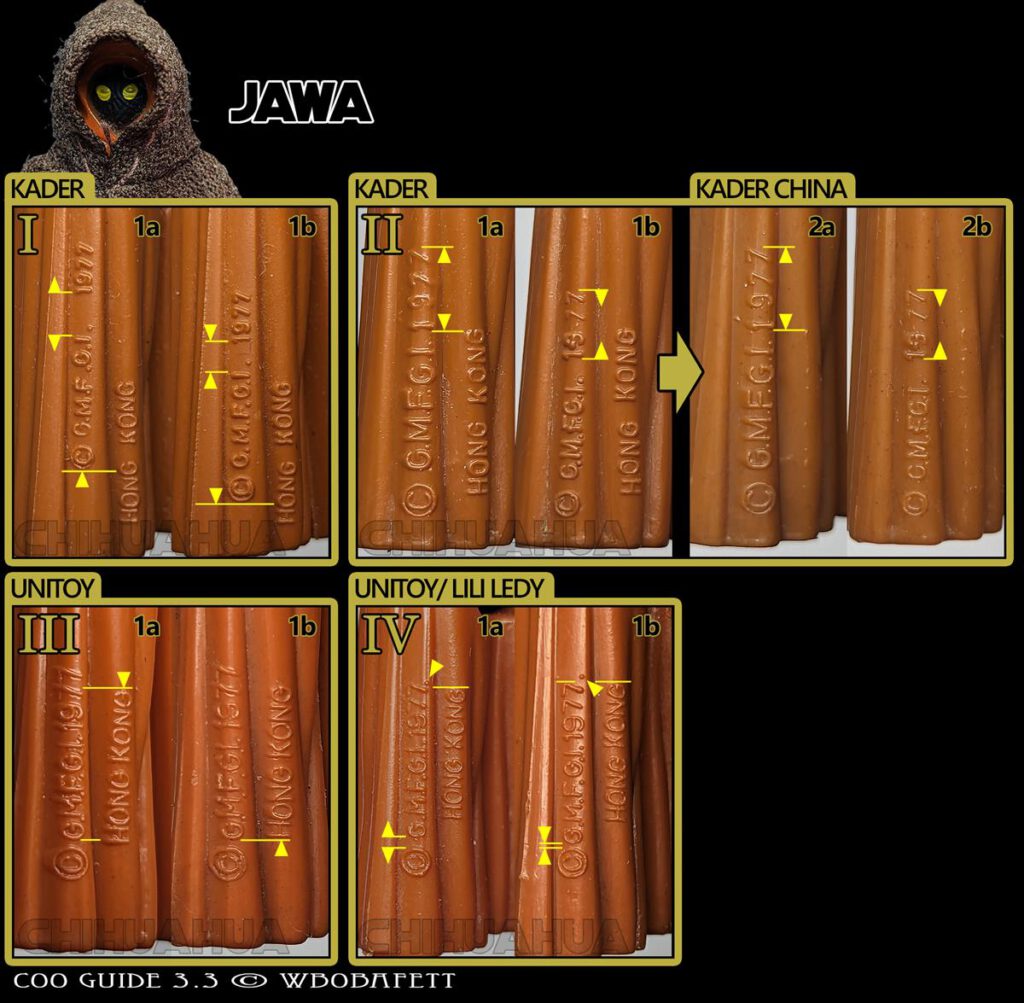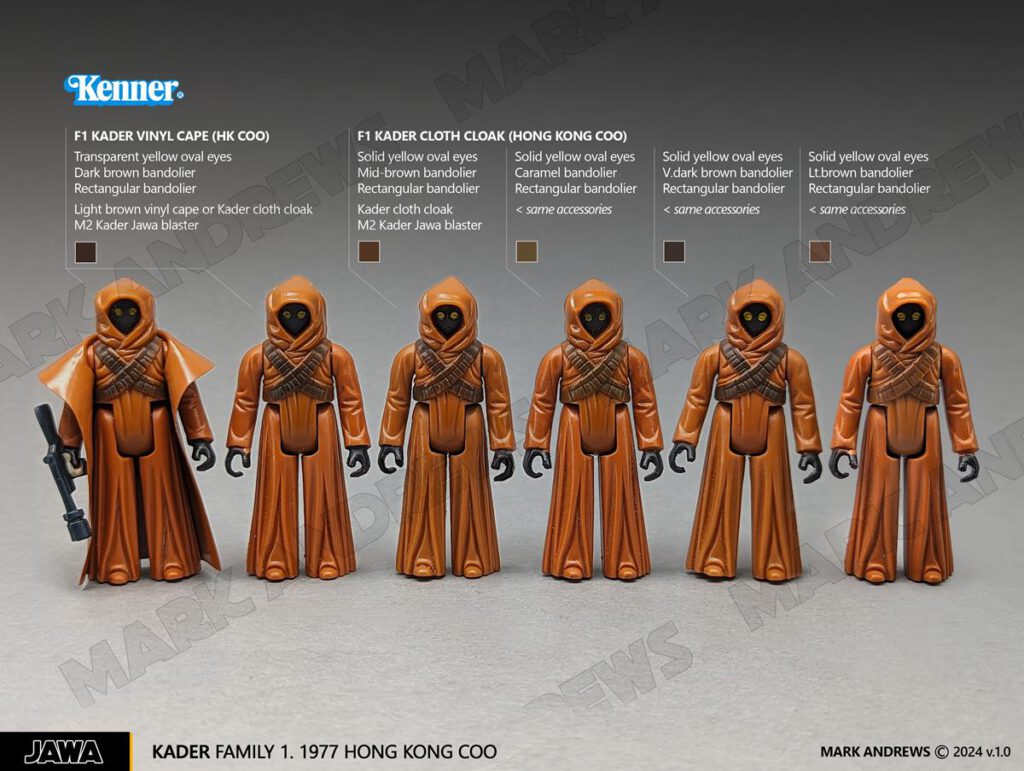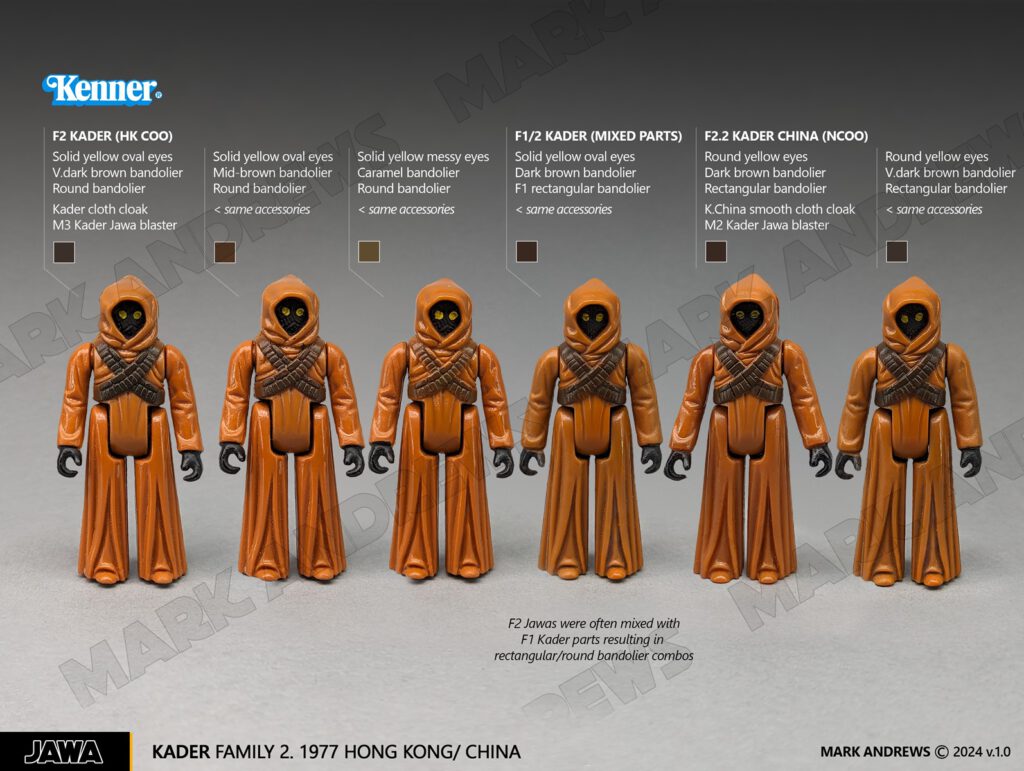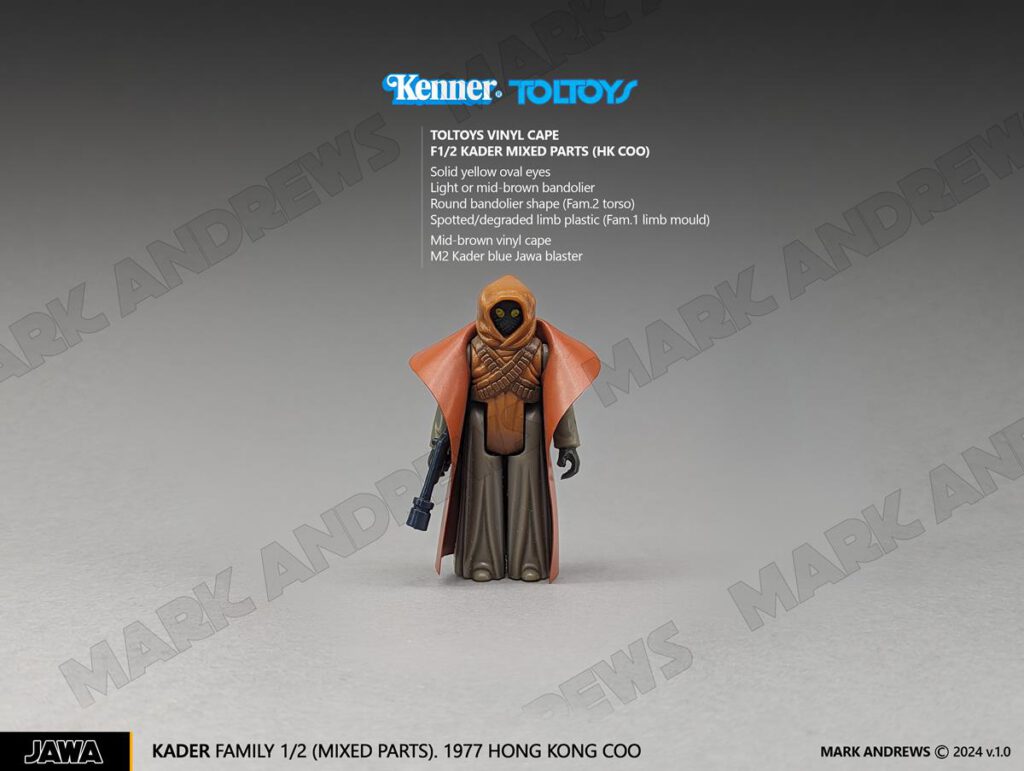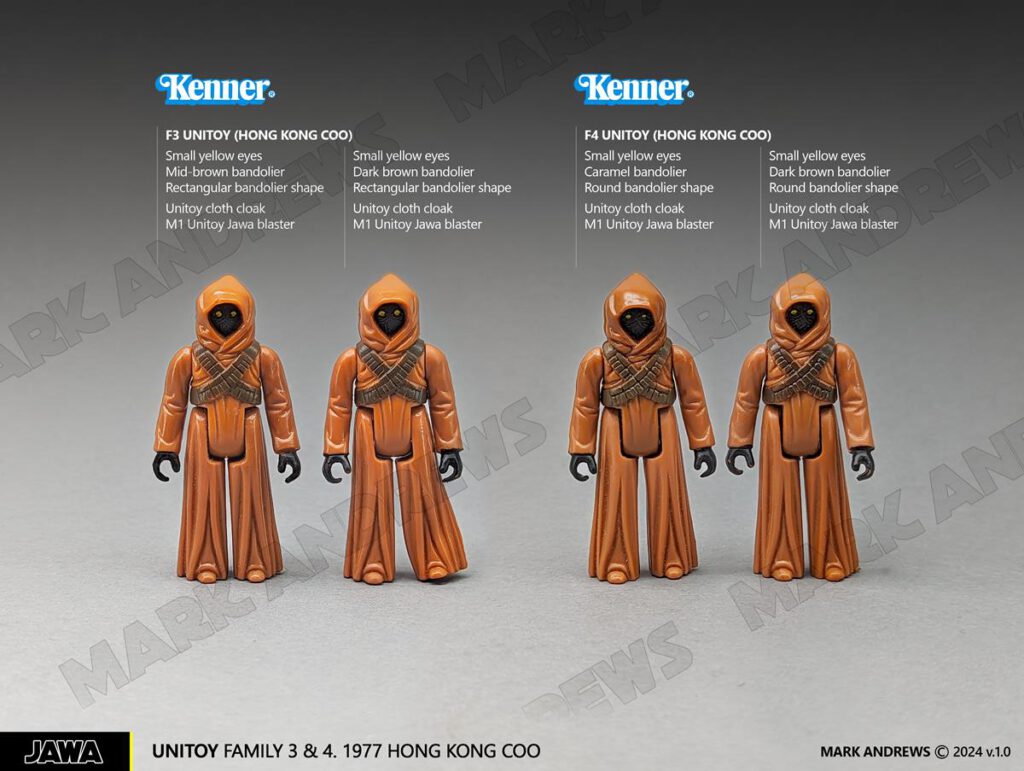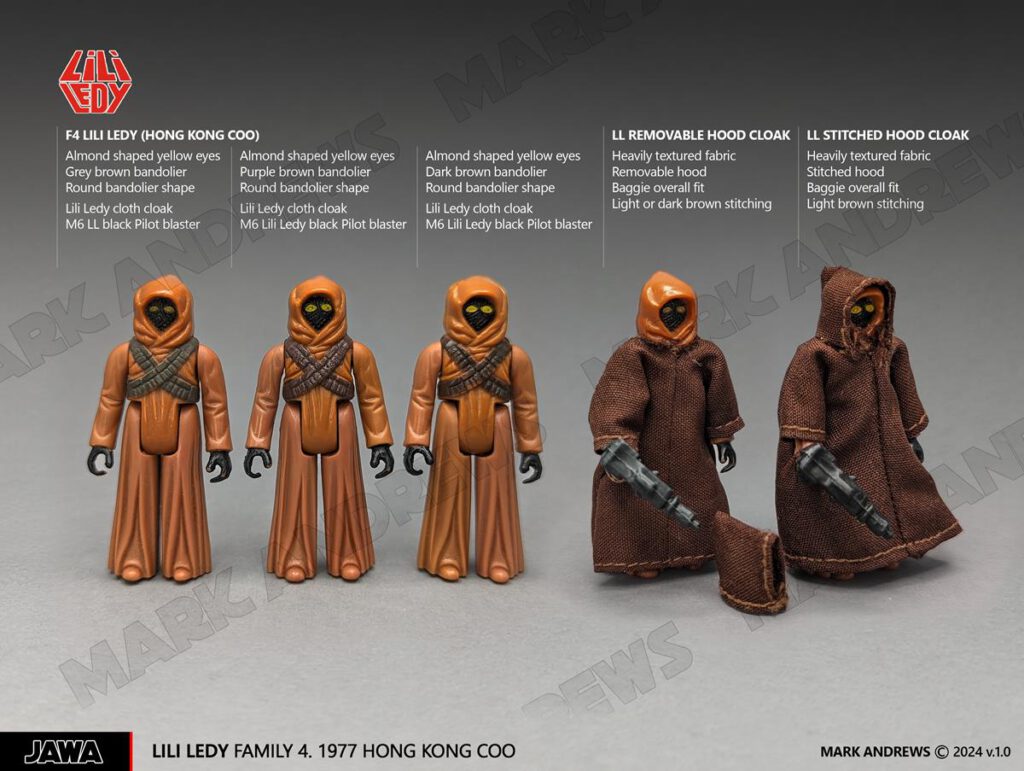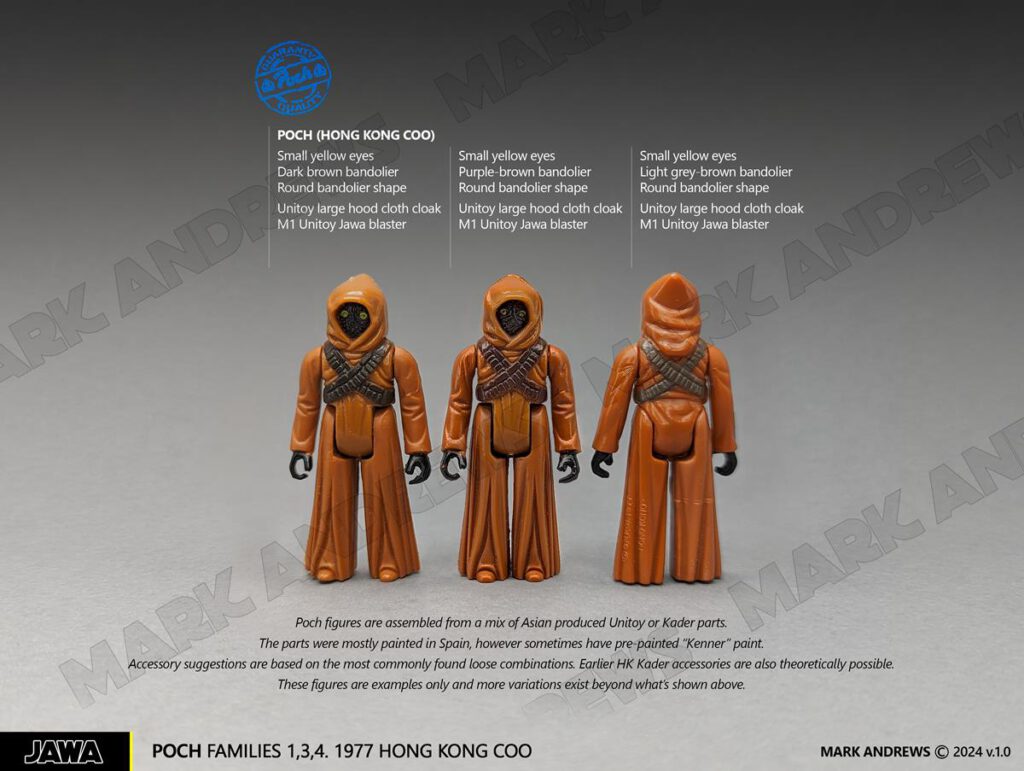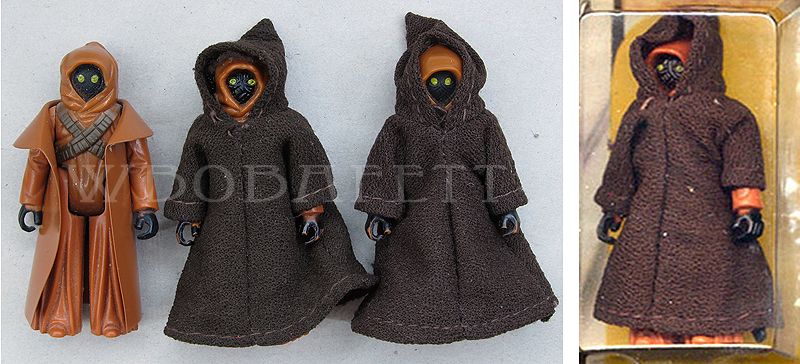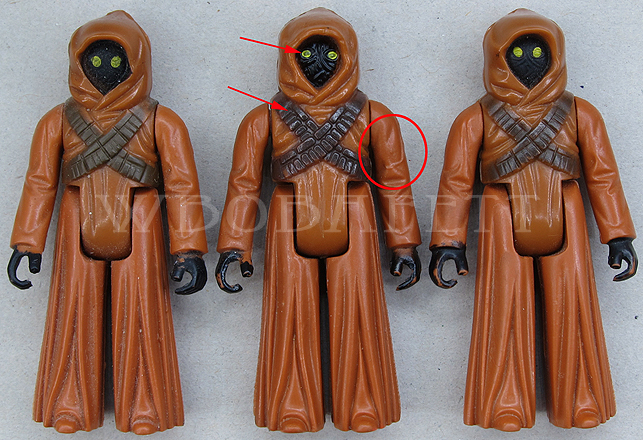Jawa
Chihuahua
TABLE OF CONTENTS
KADER HONG KONG
Above you can see following figure and accessory combinations (left to right):
- Vinyl Cape. Rectangular, very dark brown bandolier. Transparent oval yellow eyes.
- Rectangular, dark brown bandolier. Transparent yellow oval eyes. Cloth Cloak
- Rectangular, mid-brown bandolier. Solid yellow oval eyes. Cloth Cloak
- Rectangular, caramel bandolier. Solid yellow oval eyes. Cloth Cloak
- Rectangular, very dark brown bandolier. Solid yellow oval eyes. Cloth Cloak
- Rectangular, light brown bandolier. Solid yellow oval eyes. Cloth Cloak
The eye paint application was improved over time to a more vibrant solid yellow and the bandolier colours vary considerably through this period of time. The various bandolier colours are a result of inconsistent colour matching while applied over many years at a variety of different locations. As the bandolier itself can’t be seen from a dressed figure, it’s unlikely the vendor, young buyers or Kenner themselves would have cared that much for such minor paint variations as this.
The torso halves for this mould family reappear later in the Kader China production era (refer F2.2). The F1 limbs reappear later in the Toltoys Jawa release shot in a plastic which has proven to be highly prone to degradation.
KADER HONG KONG
Above you can see following figure and accessory combinations (left to right):
- Rounded, very dark brown bandolier Solid oval yellow eyes. Cloth cloak.
- Rounded, mid-brown bandolier Solid oval yellow eyes. Cloth cloak.
- Rounded, caramel brown bandolier Solid oval yellow eyes. Cloth cloak.
- (F1/F2 mixed parts) Rectangular, dark brown bandolier Solid oval yellow eyes. Cloth cloak.
KADER (CHINA) NCOO
- Rectangular dark brown bandolier Round yellow eyes. Smooth cloth cloak.
- Rectangular, very dark brown bandolier Round yellow eyes. Smooth cloth cloak.
(Colour and torso combinations will vary beyond what’s shown above)
Due to the cloak, it’s impossible to be completely certain when the F2 moulds began production, though from the eye spray mask and hand details, I believe this to be a mid-ESB era figure. The most obvious difference is the rounded bandolier moulding and to a lesser degree, the improved F2 limbs.
There were however issues with these newer F2 moulds, as the limb joints often didn’t fit together snugly into the F2 torso when assembled. As possible a result, these figures didn’t get a long production run. As both F1 & F2 torso parts were present at the same time and location, there’s many examples where figures are assembled with a mix of rectangular and rounded bandolier torso halves. The F1 rectangular torso stocks were exhausted during this time and the moulds weren’t used again until production in China began.
The Kader China Jawa was shot from a selection of moulds from both F1 & F2 families: The F1 rectangular torso and the F2 limbs. As a result, this China figure was the highest quality version of all the Kader made figures. The smoothed over COO aside, the figure is nearly identical to the HK produced version, with the notable exception of the cloak which is made in a smoother polyester type of material.
F1/F2 Kader parts: Toltoys Vinyl Cape
KADER HONG KONG
Above you can see following figure and accessory combinations (left to right):
- Toltoys Vinyl Cape. Rounded, light or mid-brown bandolier. Solid oval yellow eyes. Degraded limbs
This figure should be seen as a completely separate variant to the original vinyl caped SW-era Jawa release and is traced back to a 41-e cardback, distributed to the Australian market by Toltoys. Of course there was nothing deliberate in the production of this odd little figure. In truth this is most likely from a “seconds” grade batch of figures, assembled and accessorised with a poorly die-cut cape.
This figure was cobbled together from a mix of two mould families and the vinyl material available at Kader’s Hong Kong based factory at the time.
Some notable points about the figure itself which make it unique. The parts used for this short release are a mix, where the limbs are F1 (note thumb and COO), while torso is from F2 (note rounded bandolier). It’s the opposite parts combination to what was used in Kader China’s superior version of the Jawa.
The plastic used by Kader is notorious for degrading, and while you can find all kinds of Jawas with degraded limbs, it’s a near certainty that the plastic for the Toltoys Jawa will be either green spotted or have turned completely green (as pictured).
The cape is the darker vinyl used on the Ben Kenobi cape. As the original lighter brown vinyl was disused years earlier, this darker material was the only vinyl in circulation at the mid-ESB era of production. It’s common for these capes to be poorly die cut, although there are tells which help us authenticate genuine examples from the plethora of fake’s in circulation after decades of badly cut down Ben capes and more recently higher quality fakes flooding the collectors market.
The blaster should ideally be the bluish version of the M3 Jawa blaster. This has been confirmed on a few surviving MOCs and fits with Kader’s colour selection for accessories through this era of production.
UNITOY HONG KONG
Above you can see following figure and accessory combinations (left to right):
- F3 Rectangular, mid-brown bandolier. Small dot yellow eyes. Cloth cloak,
- F3 Rectangular, dark brown bandolier. Small dot yellow eyes. Cloth cloak
- F4 Rounded, caramel bandolier. Small dot yellow eyes. Cloth cloak
- F4 Rounded, dark brown bandolier. Small dot yellow eyes. Cloth cloak
(Colour and torso combinations will vary beyond what’s shown above)
The Unitoy Jawa debuted on the 12 bk card. This figure continue from SW through to the ESB era and the last Unitoy release I found was on the 47bk. The F3 Jawa was produced with the rectangular mould and the F4 Jawa with the rounded bandolier mould, although mixed rect./rounded examples are also fairly common. These were produced in the same factory after all and parts from different runs would have overlapped during assembly. As the figure is cloaked and sealed in a bubble, there’s no way to determine which set of tooling was used and when.
The Unitoy figures were shot in a darker reddish-brown plastic. Another key detail is the eyes, which are small yellow dots as opposed to the larger oval/rounded versions found on the Kader versions. Mould families aside, there is no difference between both Unitoy families in the plastic or paint application.
There was no Unitoy release with a Vinyl Cape. The Unitoy cloaks tended to have a loose, oversized fit and a larger hood.
Lili Ledy
Lili Ledy
LILI LEDY HONG KONG
Above you can see following figure and accessory combinations (left to right):
- Grey brown, rounded bandolier
- Purple brown, rounded bandolier
- Dark brown, rounded bandolier
- Removable hood cloak
- Stitched hood cloak
During the ROTJ era, the family 4 tooling was sent to Lili Ledy in Mexico to begin production their production of the Jawa figure. The Lili Ledy Jawa was released on the 50 back Regreso card. This is an exiting variation with many unique features when compared to it’s Kenner counterpart.
Most immediately, the bright yellow, almond shaped eyes set this figure apart. The bandoliers were painted in subtle shade variations (as shown above) which vary to the other licensees. Another distinct feature of this figure was the production decision to give him a removable hood on the cloak. The removable hood cloak is found with light and dark stitching and in vary low numbers, the hood can be found attached to the cloak.
There are two slight colour variations noted on the plastic limbs of the LL figure as shown the image above: yellow-brown and reddish-brown.
The last peculiar choice Lili Ledy made with this figure was to package him with their own in-house version of the pilot blaster instead of the more conventional Jawa blaster. Speculating here, but I believe the tooling for the Jawa blaster was still needed in Asia for the Kenner Jawa production run. Lili Ledy improvised and used the same blaster accessory they’d previously created for Nien Nunb, which also just happened to fit snugly into the Jawas hand.
POCH 1977 HONG KONG
Above you can see following figure and accessory combinations (left to right):
- Dark brown bandolier
- Purple-brown bandolier
- Light grey-brown bandolier
The Poch Jawa figure was assembled from a combination of Asian produced Kader and Unitoy parts. The figure itself at a glance is similar to it’s Kenner counterpart, however the tells below are a good start to differentiate the Kenner and Poch counterparts from one another.
The paint on the face and hands is a glossy black. The pupils are very small lighter yellow shade and often can be positioned very unevenly. There is often a plastic burr on the torso from parts being twisted from the sprue instead of cut cleanly. Lastly, the sonic weld holding the figure together is often weak and torso halves can partially, or completely separate.
The bandolier colour is most often either a dark brown, sometimes with a purple hue or a light grey-brown version. I have seen Poch Jawa’s with mid-brown bandolier paint, however these are likely to have Kenner paint applied in Asia before being exported to Spain. Due to the mixed-up nature of Poch figures, either bandolier types was possible to be used in the assembly of a figure.
The Kader parts seem to be specifically from family 1 and Unitoy parts from families 3 and 4. If anyone has Poch examples that contradict this information, please get in touch and I’ll revise the content here.
The figure shown in the middle above is assumed to be the Poch variant of the Jawa. It is compared to his Kenner COO counterparts (left and right). The most obvious difference, with the cloth cape on, is the very unique sprayed eyes. Compared to the carded one this is a total match. I would also say that the cloth cape found with this loose one is the correct one. There is very less differences to a Kenner one, but it seems that the stitching is a bit wider especially on the hem below, not much, but maybe a hint.
Shown above is the Poch Jawa without cloth cape compared to its HK counterparts. What can be noticed first is the darker paint on the strap. If you have a closer look you will notice that the mould of the strap is different too. This is a mould from another HK-family/series and got probably mixed up in the PBP factory. The black paint applied on face and hands is much glossier and there is some sort of “irregularity” in the mould of the right arm. It looks like an additional “pleat” but it’s from a damaged steel-mould. The “flashing” on the legs seems also typical for this variant.
